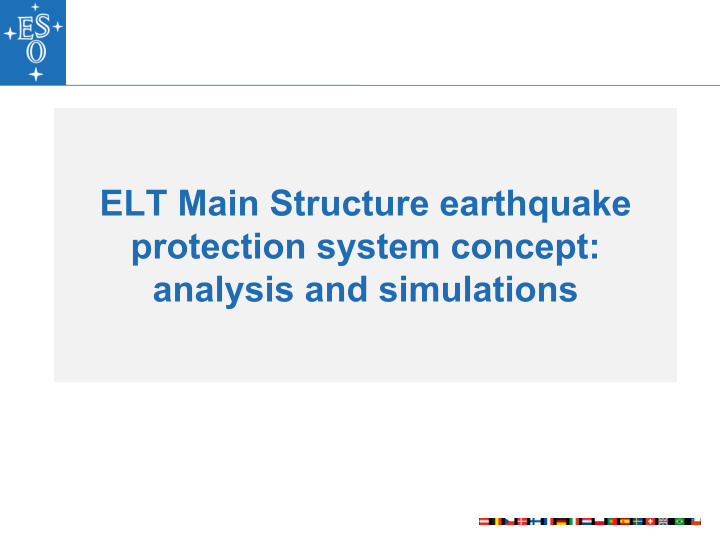



ELT Main Structure earthquake protection system concept: analysis and simulations
Concept Hydraulic system based on oil cylinders connected to accumulators
Concept: Accumulators Accumulators configuration A and B Bladder Piston
Modelling modelled and simulated using Matlab/Simulink The model is composed of two main elements: 1) The model of hydraulics including pad cylinders, pipes, accumulator and throttle-check valves. 2) The telescope structure is modelled: ➢ a lumped mas/spring representing the equivalent mass seen by one of the supporting pads, i.e. 1/80 th of telescope mass and representing the first eigenmode of the telescope ➢ complete FEM representing all modes and mirror unit 6DOF motions.
Model: Hydraulic System Cylinder representing the oil volume: uses the oil flow, the position and velocity of the piston (cylinder) to compute the resulting force transmitted to the interface of the telescope model. The compressibility of the oil is used to represent the physical phenomenon. Pipes models represent three effects of i) the compressibility of the oil, ii) the friction of the pipe to limit the flow or to generate a pressure drop, iii) the dynamic effect of the varying flow using the inertial properties of the oil volume. Two configurations of Accumulators : Configuration A and B The inlet and outlet flow characteristics of the valves , i.e. flow as a function of differential pressure, are defined based on same lookup tables. The tables are used from the data sheet of some manufacturers (here Boch Rexroth).
Mechanical system Two mechanical models are used to study the effect of the protection system: telescope structure is represented by a lumped mass 1) spring system ➢ to simplify the problem, reduce the computations and potential numerical issues and to focus on the principle of the hydraulic concept itself assumes the complete FEM of the telescope structure 2) representing the dummy mirrors and their 6DOF motions ➢ level of the motions/accelerations at sensitive unit locations, e.g. M1, M2, during earthquake before and after the protection system activated
Proof of concept Two lumped mass and a spring system ➢ The model assumes only one pad or protection system, consequently it is assumed to act on 1/80 th of the telescope mass ➢ A parametric model is constructed where the values of two mass, one representing the base and the second the telescope structure, and the spring can be tuned such to vary the principle oscillation mode of the telescope, e.g. 3 or 4Hz. The mass/spring system receives the force from the hydraulic cylinder as input (force to the base mass) and provides the difference motion of the ground and the base (as well as the speed) to the cylinder.
Complete system FEM model of the telescope expressed in state- space format with appropriate inputs and outputs The model represents 200 modes (400 states) of the structure up to 20Hz. The main outputs of the model are the differential motion of the cylinders at location of the 80 pads, and motions of the telescope mirrors. The inputs to the model are the forces at the telescope interface to the pier (80 forces at pad locations), and the ground motion in three x, y and z directions.
Combined model diagrams
Model diagrams
Parameters Design and simulation parameters of the hydraulics system Initial oil pressure of each cylinder: 120 [bar] Ambient temperature (for oil characteristics) 9 [deg] Cylinder area and diameter: * beta 0.028[m^2], 0.19 [m] Initial volume of Cylinder (oil): area * 0.2 0.0056 [m^3] Pipes lengths 1 [m] Pipes diameter 0.0762 [m] (3 inch) Initial nitrogen pressure of accumulator A (compressed accumulator) 125 [bar] Initial nitrogen pressure of accumulator B (decompressed accumulator) 115 [bar] Initial Cylinder (oil) pressure 120 [bar] Initial Volume of accumulator A and B 18.4 e-3 [m^3] Characteristic of None Reversible Valve (NRV) for accumulator A (inlet) and B (outlet) See Table 3 Characteristic of Throttle valve for accumulator A (outlet) and B (inlet) See Table 2
Parameters: valves Characteristics of the throttle valves (accumulator A and B) LUT Pressure 0.1e5 0.5e5 1e5 2e5 3e5 4e5 5e5 [P] Flow 13e-3 35e-3 52e-3 77e-3 95e-3 110e-3 125e-3 [m^3/min] Characteristics of the NRV valves (accumulator A and B) LUT Pressure 0.25e5 0.5e5 0.9e5 1.2e5 2e5 3e5 [P] Flow 30e-3 75e-3 150e-3 225e-3 300e-3 375e-3 [m^3/min]
Assumptions Telescope mechanical system parameters for lumped mass spring assumption Total moving mass (Telescope Base mass Mt 1 Flexible mass Telescope main Damping mass/80 = Mt) [kg] [kg] resonant factor Mt 2 [kg] frequency [Hz] 3.45e6 /80 = 43125 0.2* Mt = 8625 0.8*Mt = 34500 4 0.01 Ground acceleration in Z direction due to a NCR earthquake
Simulation results: proof of concept Lumped mass/spring model Device ‘off’ Accelerations Motions
Simulation results: proof of concept Lumped mass/spring model Device ‘On’ Accelerations Motions
Simulation results Cylinder Force Pressure and Flow in accumulators
Simulation Results: proof of concept
Simulation results: complete system FEM model Device ‘Off’ Accelerations Motions
Simulation results: complete system FEM model Device ‘On’ Accelerations at M2 unit Motions
Simulation results: complete system Cylinder Force Pressure and Flow in accumulators
Simulation results: complete system Accelerations M2 z: system ‘off’ and ‘on’ Accelerations M1 z: system ‘off’ and ‘on’
Simulation results: complete system Effect of pressure/force threshold parameter Reminder: System ‘off’ M2 z acc 0.6 [g] rms
Recommend
More recommend